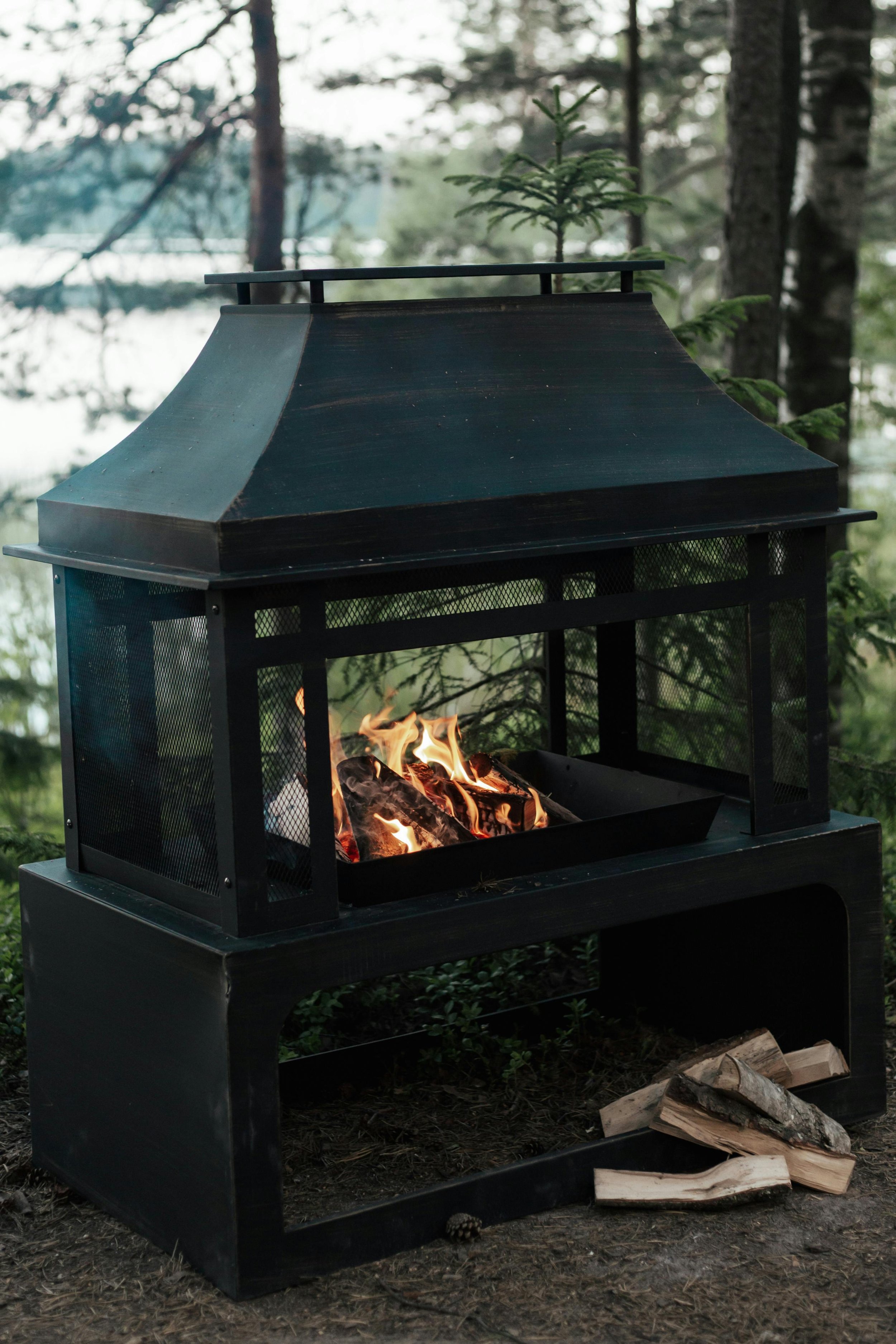How Does a Smokeless Fire Pit Work? Find Out Here
Curious about How Does a Smokeless Fire Pit Work? Find Out Here. Discover the science behind smokeless fire pits, their benefits, and how they create a cozy, smoke-free atmosphere.
Picture this: a crisp evening, your favorite beverage in hand, and a crackling fire to warm your spirits. Sounds perfect, right? But wait, what about the smoke that inevitably seems to follow you around the fire pit, making you smell like a campfire for days? Enter the smokeless fire pit—a game-changer for those who love the ambiance of a fire without the nuisance of smoke.
In this article, we’re diving into the world of smokeless fire pits. If you’ve ever wondered, “How Does a Smokeless Fire Pit Work? Find Out Here,” you’re in the right place. We’ll explore the science behind these modern marvels, how they differ from traditional fire pits, and why they might just be the perfect addition to your outdoor space.
How Does a Smokeless Fire Pit Work? Find Out Here
1. The Basics of Fire Pit Design
Before we dig into the smokeless features, let’s brush up on the basics of fire pits. Traditional fire pits work on a simple principle: fuel burns in an open space, creating heat and light. However, they also produce smoke, which is a byproduct of incomplete combustion.
Smokeless fire pits, on the other hand, are designed with advanced technology to minimize smoke production. Here's how they do it:
Double-Walled Construction: Smokeless fire pits typically feature a double-walled construction, consisting of two layers of metal with an air gap in between. This design facilitates improved airflow, promoting more complete combustion of the fuel. The result is a cleaner burn with significantly reduced smoke. The double-walled setup ensures that the fire pit operates more efficiently, providing a more enjoyable and less smoky experience.
Airflow Technology: Smokeless fire pits utilize advanced airflow technology, featuring strategically placed air vents and channels. These components direct airflow to enhance secondary combustion, ensuring that smoke from the initial burn is re-burned within the fire pit. This process effectively reduces smoke emissions and allows for a cleaner, more efficient fire. By promoting complete combustion, these fire pits minimize smoke and provide a more enjoyable outdoor experience.
2. Understanding Secondary Combustion
So, what’s all this talk about secondary combustion? It’s a key player in the smokeless fire pit game. Here’s how it works:
Initial Combustion: During initial combustion, the fuel, such as wood or pellets, ignites and begins to burn, producing both heat and smoke. This stage is essential for generating the intense heat required for the fire pit to function. As the fuel burns, it releases smoke, which is a byproduct of incomplete combustion. Efficient combustion and airflow management are key to minimizing smoke and enhancing the overall performance of the fire pit.
Air Intake: The double-walled construction and air vents in a smokeless fire pit facilitate the intake of fresh air. This air is drawn into the fire pit and preheated by the surrounding hot gases before reaching the combustion area. The preheated air helps to support more efficient burning of the fuel, promoting a hotter and cleaner fire. This process enhances combustion and reduces smoke production, resulting in a more enjoyable fire pit experience.
Secondary Combustion: The preheated air is introduced into the fire at a higher level, promoting secondary combustion. This additional air helps to ignite and burn off smoke particles that didn’t fully combust during the initial burn. As a result, the fire produces cleaner, hotter flames with minimal smoke. This secondary combustion process enhances the efficiency of the fire, providing a more enjoyable and smoke-free experience.
3. Benefits of a Smokeless Fire Pit
Aside from the obvious advantage of reduced smoke, there are several other perks to using a smokeless fire pit:
Cleaner Air: With reduced smoke, a smokeless fire pit ensures cleaner air, making it easier to breathe. This decrease in smoke not only enhances comfort but also prevents the smoky smell from lingering on clothes and skin. Enjoying your fire without the unpleasant side effects of smoke improves the overall experience, making gatherings and relaxation around the fire more pleasant and enjoyable.
Enhanced Heat Output: Smokeless fire pits are designed to burn more efficiently, which results in enhanced heat output. They produce a warmer fire with less fuel due to their advanced combustion technology. This efficient burning means you get more warmth from your fire pit, making it a more effective and economical option for staying cozy. The reduced waste also contributes to a cleaner, more enjoyable fire experience.
Less Maintenance: Smokeless fire pits require less maintenance due to their efficient burning process. With fewer ashes and less soot, you'll spend less time cleaning up after each use. This means your fire pit remains looking great with minimal effort, allowing you to enjoy your outdoor space without the hassle of frequent maintenance. The reduced mess also contributes to a more pleasant and hassle-free fire experience.
Improved Aesthetics: With cleaner burns, the flames tend to look more vibrant and less obstructed by smoke. Your fire pit becomes more of a focal point for your outdoor space.
4. Choosing the Right Smokeless Fire Pit
When it comes to selecting a smokeless fire pit, consider the following factors:
Size and Style: Smokeless fire pits enhance the aesthetics of your outdoor space by providing cleaner, more vibrant flames. With minimal smoke obstructing the view, the flames appear clearer and more striking, making your fire pit a standout feature. This improved visual appeal transforms your fire pit into a captivating focal point, adding a touch of elegance and ambiance to your outdoor gatherings.
Fuel Type: Smokeless fire pits come in various fuel types, including wood, propane, and natural gas. Each type offers different benefits and convenience levels. Wood-burning models provide a traditional fire experience with the crackling sound and aroma of burning wood. Propane and natural gas models offer more control and convenience with adjustable flames and easy ignition. Choose a fire pit based on your fuel availability and preferences to ensure it meets your needs and enhances your outdoor experience.
Material: When selecting a smokeless fire pit, consider the material to ensure durability and longevity. High-quality options like stainless steel and cast iron are excellent choices, as they can withstand high temperatures and harsh weather conditions. Stainless steel is known for its resistance to rust and corrosion, while cast iron offers superior heat retention and strength. Choosing a fire pit made from these materials will ensure it remains a reliable and attractive addition to your outdoor space for years to come.
Price Range: When shopping for a smokeless fire pit, consider the price range carefully. While budget options may seem appealing, investing in a higher-quality model often leads to better performance and longer-lasting durability. Quality fire pits typically offer improved efficiency, better materials, and enhanced features, ensuring a more satisfying and reliable experience. Balancing your budget with the benefits of a well-constructed fire pit can enhance your outdoor enjoyment and provide greater value over time.
Conclusion
Understanding How Does a Smokeless Fire Pit Work? Find Out Here sheds light on the fascinating technology that makes these modern fire pits such a hit. By incorporating features like double-walled construction and advanced airflow systems, smokeless fire pits provide a cleaner, more efficient burning experience. They offer not just a cozy flame, but also enhanced air quality and less maintenance hassle.
So, if you're tired of dodging smoke and dealing with the aftermath of traditional fire pits, a smokeless fire pit might just be the upgrade your outdoor space needs. Enjoy those warm, crackling fires without the smoke—and make your evenings around the fire pit all the more pleasant!
Frequently Asked Questions
How does a smokeless fire pit reduce smoke?
A smokeless fire pit reduces smoke by using a double-walled design and airflow technology to achieve secondary combustion. This burns off smoke particles before they escape into the air.
Can I use wood in a smokeless fire pit?
Yes, many smokeless fire pits are designed to use wood, though some models are designed for propane or natural gas. Check the manufacturer’s guidelines for the appropriate fuel type.
Are smokeless fire pits safe to use?
Yes, smokeless fire pits are generally safe when used according to the manufacturer’s instructions. They are designed to burn more cleanly and efficiently, reducing the risk of flare-ups and excessive smoke.
How do I maintain my smokeless fire pit?
Regular maintenance includes cleaning out ashes, checking for any signs of wear or damage, and ensuring that the air vents are not obstructed. Follow the manufacturer’s maintenance recommendations for best results.
What makes a smokeless fire pit different from a traditional fire pit?
A smokeless fire pit differs from a traditional fire pit in its design and technology. It features double-walled construction and airflow systems to promote secondary combustion, which reduces smoke production and improves heat output.



